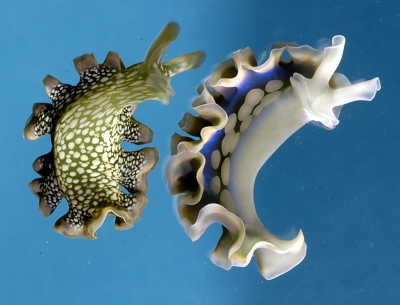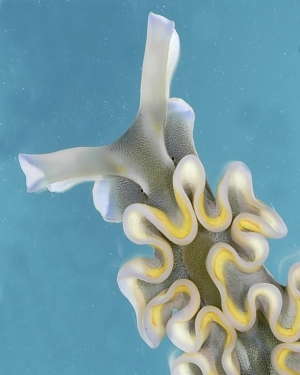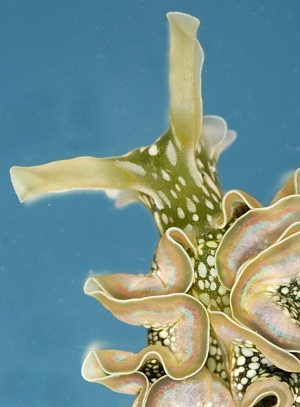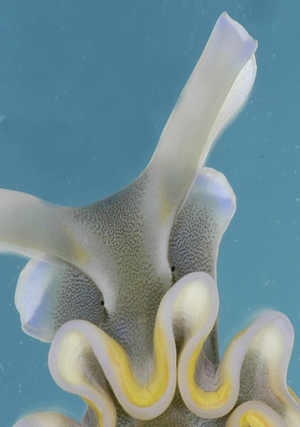Elysia clarki and E. crispata in Florida
October 10, 2007
From: Skip Pierce

Hi Bill
Attached are a couple of comparative photos you may be interested in (taken by my post doc Nick Curtis and our colleague Ray Martinez) that provide a further comparison of Elysia clarki and Elysia crispata, this time both from Florida. Recently, we've had the opportunity to sample populations that are geographically very close to each other, probably 2-3 miles apart as the crow flies (or fish swims). The E. clarki came from mangrove swamps on the Keys and the E. crispata came from the offshore reefs of the Florida Keys National Marine Sanctuary at Looe Key- (all specimens were collected with permits from the State of Florida or from NOAA). Of course, the habitat differences between the swamps and reefs are large with respect to physical, chemical and biological properties.
Locality: Florida Keys, USA, Atlantic Ocean/Florida Bay, Oct. 2007. Length: 15-20 mm. Upper photo: Left: E. clarki, showing green aggregations of chloroplast on sole of foot. Right: E. crispata showing lack of green chloroplasts on sole of foot. Middle photos: Left: E. crispata showing anterior end of parapodia fused. Right: E. clarki showing gap between anterior end of parapodia. Lower photo: E. crispata showing aggregations of green chloroplasts on head foot and parapodia. Photos: Nick Curtis and Ray Martinez.
As you may remember, the E. crispata specimens we used in our paper describing E. clarki, came from the Virgin Islands, pretty far away from Florida. But the E. crispata in these photos are identical in morphology to those from the Virgin Islands (including the opaque foot and fused parapodia), and as you can see, quite different from E. clarki, as we described. We are going to do some DNA comparisons with these Florida E. crispata and E. clarki (and the DNA data we developed from the E. clarki that Colin Redfern sent us from Abaco). That will also tell us whose chloroplasts are present in the Looe Key specimens. However it'll take us several weeks to do those experiments. By the way, the bright blue color of the E. crispata in this photo, is not always present (but also occurs in some of the Virgin Island E. crispata, as we reported) - possibly from something they've eaten, but maybe not. We have never seen that blue in 1000's of E. clarki.
Skip
pierce@cas.usf.edu



Dear Skip,
Thanks for these great photos. I wonder how anyone ever thought these two were one species. If the fused parapodia in E. crispata and the ramifications of the digestive gland into the foot of E. clarki can be dismissed as just 'ecovariations' it would undermine our use of morphological difference as the principal indicator of phylogenetic difference.
I have included a close-up of the head of E. crispata alongside as it shows the fused anterior parapodia very well and also shows the aggregations of chloroplasts [green specks ] which they have obtained from their algal food.
Best wishes,
Bill Rudman
Related messages
-
Relationship of Elysia diomedea and E. crispata
From: Patrick Krug, October 6, 2008 -
Elysia clarki feeding practices
From: Adam D'Agosto, December 6, 2007 -
Re: Elysia crispata in Cozumel, Mexico
From: Skip Pierce, February 2, 2007 -
Re: Elysia crispata in Cozumel, Mexico
From: Jim Lyle, February 2, 2007 -
Re: Elysia crispata in Cozumel, Mexico
From: Sean Kearney, February 2, 2007 -
Re: Elysia crispata in Cozumel, Mexico
From: Skip Pierce, February 1, 2007 -
Elysia crispata in Cozumel, Mexico
From: Sean Kearney, January 29, 2007 -
Elysia clarki feeding references
From: Nicholas Curtis, January 29, 2007 -
Re: What's wrong with Elysia clarki?
From: Colin Redfern, September 9, 2006 -
Re: What's wrong with Elysia clarki?
From: Colin Redfern, September 9, 2006 -
Re: What's wrong with Elysia clarki?
From: Skip Pierce, September 8, 2006 -
Re: What's wrong with Elysia clarki?
From: Angel Valdes, September 7, 2006 -
Re: What's wrong with Elysia clarki?
From: Skip Pierce, September 1, 2006 -
Re: Damaged Elysia crispata
From: Nick Curtis, August 31, 2006 -
What's wrong with Elysia clarki?
From: Bill Rudman, August 30, 2006 -
Elysia diomedea & E. clarki in home aquarium?
From: Matt Pedersen, May 30, 2006 -
Elysia clarki breeding in the home aquarium
From: Matt Pedersen, May 30, 2006 -
Elysia clarki, E. diomedea and E. crispata
From: Bill Rudman, May 30, 2006 -
A new Elysia from Florida
From: Bill Rudman, May 30, 2006 -
Lettuce Sea Slug behavior and feeding
From: Patrick Glenn, April 13, 2006 -
What to feed Elysia crispata?
From: Alexandra Ahnide, April 11, 2006 -
Elysia crispata feeding and babies
From: Willem Bermel, January 31, 2006 -
Re: Colour in Elysia (again)
From: Anne DuPont, November 7, 2005 -
Re: Lettuce sea slug - breeding success
From: Vincent, June 27, 2003 -
Lettuce sea slug - breeding success
From: Rick Hahn, May 31, 2003 -
Re: Gene transfer - Elysia crispata
From: Skip Pierce, May 5, 2003 -
Re: Algal genes in Elysia crispata
From: Philip Cromwell, May 3, 2003 -
Re: Elysia crispata and algal genes
From: Skip Pierce, May 3, 2003 -
Algal genes in Elysia crispata
From: Skip Pierce, May 2, 2003 -
Elysia crispata babies
From: Joe Bongiorno, December 30, 2002 -
Re: Baby slugs!
From: Joe Bongiorno, December 18, 2002 -
Re: Baby slugs!
From: Joe Bongiorno, December 10, 2002 -
Bifid rhinophores in Elysia crispata
From: Anna L. Bass, September 12, 2002 -
Elysia crispata? in aquaria
From: Ash, April 1, 2002 -
Re: Baby slugs! - Elysia crispata
From: Jeff Zimmerman, June 4, 2001 -
Re: Baby slugs! - Elysia crispata
From: Jeff Zimmerman, March 22, 2001 -
Baby slugs!
From: Jeff Zimmerman, March 17, 2001
